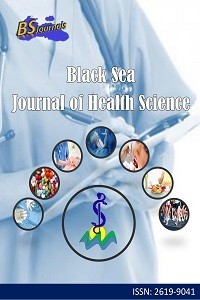Internet Addiction among Secondary School Students Conditioned By Gender and Age
Internet Addiction among Secondary School Students Conditioned By Gender and Age
internet addiction, Addictions, Gender, Age,
___
- Bugarski V. 2018. Internet addiction on the way to the new diagnostic category, 1st ed. Autorsko Izdanje, Beograd, Serbia, pp. 5-17.
- Fitria L, Ifdil I, Erwinda L, Ardi Z, Afdal A, Sari A. 2018. Exploring internet addiction on adolescents. J Physics: Conference Series, 1114: 012076. DOI: 10.1088/1742-6596/1114/1/012076.
- Fumero A, Marrero R, Voltes D. 2018. Personal and social factors involved in internet addiction among adolescents: A meta-analysis. Comp Human Behav, 86: 387-400. DOI: 10.1016/j.chb.2018.05.005.
- Grujić V. 2020. Personality traits and internet addiction. Philosophy, 1: 25-27.
- Jović J. 2011. The influence of the dopaminergic system on the Internet addiction, Special Educ and Reh, 7: 3-5.
- Kimberly Y. 2017. Internet addiction: A handbook and guide to evaluation and treatme, 3rd ed. John Wiley & Sons, Hoboken, USA, pp. 30-33.
- Lepojevic KM. 2011. The concept and characteristics of Internet addiction. Special Educ Rehab, 10: 4-5.
- Lukić I, Ranković D, Ranković N. 2017. The presence of internet addiction among high school students. Zdravstvena Zastita, 46(4): 33-40. DOI: 10.5937/zz1704033l.
- Mihić V, Lelović G, Olujić V. 2021. Internet behavior, gender, age and introvert effects. Faculty Phil, 1: 5-8.
- Mitrovic D, Djordjevic J, Ciric D. 2014. Use of the internet with students in Knjazevac. Timocki Med Glasnik, 39(2): 66-77. DOI: 10.5937/tmg1402066m.
- Pan P, Yeh C. 2018. Internet addiction among adolescents may predict self-harm/suicidal behavior: A prospective study. J Pediatrics, 197: 262-267. DOI: 10.1016/j.jpeds.2018.01.046.
- Przepiorka A, Blachnio A, Cudo A. 2019. The role of depression, personality, and future time perspective in internet addiction in adolescents and emerging adults. Psychiatry Res, 272: 340-348. DOI: 10.1016/j.psychres.2018.12.086.
- Sherer K. 2019. College life on-line: Healthy and unhealthy internet use. J College Stud Devel, 38(6): 655–665.
- Shubnikova E, Khuziakhmetov A, Khanolainen D. 2017. Internet-addiction of adolescents: Diagnostic problems and pedagogical prevention in the educational environment. Eurasia J Math, Sci Tech Educ, 13(8): 5261-5271. DOI: 10.12973/eurasia.2017.01001a.
- Tsai C, Lin S. 2017. Analysis of attitudes toward computer networks and internet addiction of taiwanese adolescents. Cyberpsych Behav, 4(3): 373-376. DOI: 10.1089/109493101300210277.
- Yayın Aralığı: Yılda 4 Sayı
- Başlangıç: 2018
- Yayıncı: Cem TIRINK
Bariyatrik Cerrahide Postoperatif Komplikasyonların Önlenmesinde Sağlık Okur Yazarlığının Önemi
Cemalettin DURGUN, Emine Kübra DİNDAR DEMİRAY, Sevil ALKAN, Mehmet DURGUN
Büşra ERŞAN ERDEM, Havva ERDEM
Medicinal Values of A Food Plant - Limonia Acidissima Groff
Saravanan VİVEKANANDARAJAH SATHASİVAMPİLLAİ, Pholtan Rajeev SEBASTİAN
Trisomy of 1q31.3q42.12 Chromosome: Case Report
Selma SOLGUN, Sevda CANBAY DURMAZ, Davut ÖZBAĞ, Sibel ATEŞOĞLU KARABAŞ
Ece ÖZAYKAN, Emin PALA, Suleyman ERSOY
Evaluation of the Applications to the Patient Rights Unit
Bahadır YAZICIOĞLU, Elif DİKMETAŞ YARDAN
Melek BİLGİN, Eşe BAŞBULUT, Hacer İŞLER, Cemanur AYGÜN
Premenopozal Dönem Kadınlarda Aerobik Egzersiz Eğitiminin Menopoz Semptomlarına Etkisi
COVID-19 Pnömonisi - Brusella spp. Koenfeksiyonu : Olgu Sunumu
Emine Kübra DİNDAR DEMİRAY, Hanife Nur KARAKOÇ, Hacer AKŞİT, Erdinç EREN, Özgür PAŞA, Gökhan ŞAHİN, Ömer DURAN, Fadime GÜLPINAR, Saadet YILDIRIM, Edip YILDIZ, Eren BEKTAŞ
